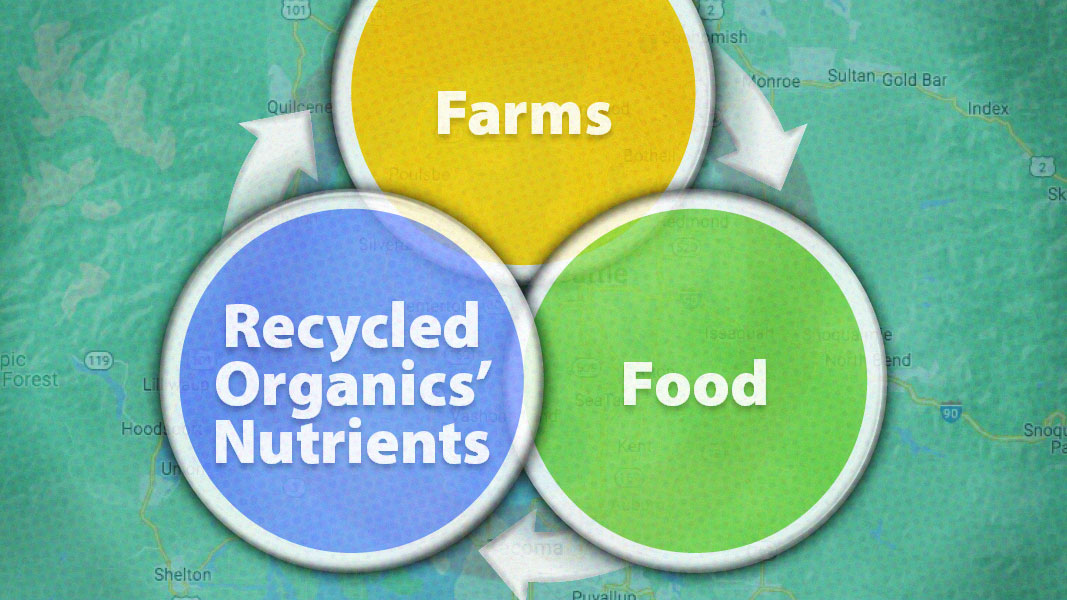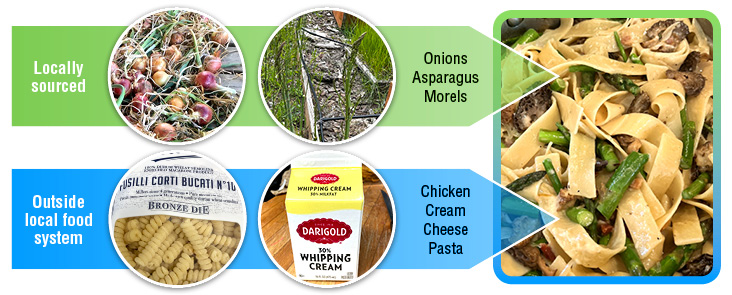Top: Food and nutrient flows in the food shed. © Google Maps.
 Sally Brown
Sally Brown
Buying new is always so much easier. This goes for outfits as well as nutrients. The ramifications for both, however, are not so good. However tempting that new floral print or that bag of N:P:K may be, the world will be better off if you resist temptation and use what you already have. That is the basic tenet of an emerging field of research that attempts to quantify nutrient flows in food systems. It turns out that taking inventory in your closet is a lot easier than doing the same with your food system. The basic principle is that you have to figure out what you consume and where it comes from. The next step is to determine what resources were used to make what you consume and where they came from. Finally, you have to consider the leftovers and whether they were put to use.
Take a recent dinner I made as an example. This is a classic spring meal — pasta with asparagus and morel mushrooms. If I hadn’t undercooked the pasta, it really would have been exceptional. Here were the sources for the ingredients: Onions and asparagus from our garden; Morel mushrooms we collected by foraging; Chicken stock made from store-bought chicken and leftover vegetables; and heavy cream, Asiago cheese and pasta bought at the store.
For this particular meal, several of the ingredients were locally sourced (onions, asparagus, morels). Several others came from outside our local food system aka the supermarket (chicken, cream, cheese, pasta). I can tell you the inputs we used in our garden (home generated compost and biosolids from outside our food system). However, I don’t know anything about the cream, wheat, cheese or chickens. I can tell you that we compost our food scraps and that the leftovers from this meal were fed to the dog (she got to lick the pan). However, our own excreta go into the septic system that is pumped out with the contents taken to I am not sure where and used for I am not sure what.
Food Systems And Nutrient Flows
When you talk about food systems and nutrient flows, you take the same basic concepts that I just described for one meal and extend them to a fixed region over time. In this context, the “food shed” is the fixed region. The “investigative” process boils down to determining if those producing the food are taking advantage of available residuals from producing and consuming the food in the process of production. To assess whether there are sufficient nutrients in the food shed to meet demand involves an accounting of the nutrients required to produce the food and the nutrient content in the food. Knowing the nutrients in the food helps you calculate how much of those are being exported or consumed wherever the final destination of the food is. Next you have to inventory the residuals from growing and eating.
For a side of ribs for example, the questions to be asked are where the food for the pig came from, how much nutrients they contained, and how much nutrients were required to grow that pig. Next you have to think about how much the pig peed and pooped while growing and where that went. Finally, you have to consider the leftovers from whoever ate the ribs and where their excreta end up. I can sense eyes starting to glaze over as you read this and a desire to go back to the pasta recipe. This type of accounting is necessary because for the vast majority of our food system the people responsible for raising the pig or growing the apples are not likely to know the people who manage the green waste or the excreta.
Before we start figuring out how to make those connections it is important to set up a baseline. We have to know how much fertility is required and where it is required before we can start taking advantage of the nutrient values of different wastes. Creating a circular economy requires knowing who has what and who needs what. That is the first challenge. The next step is making the connection between the two.
Nutrient Accounting
Some of the recent literature on the topic is helpful in understanding the nutrient accounting. All of the papers I’ve read estimate balances for nitrogen (N), phosphorus (P) and potassium (K). The ones from Europe also consider carbon (C). One group did this type of accounting for the Okanagan, an area in interior British Columbia (Harder et al., 2021). The authors surveyed what was grown in the region, the nutrient requirements for the crops, the nutrients in the crops and where they were eaten. They examined what was eaten in the region and where it came from. Finally, they looked at the leftovers including agricultural wastes, animal manures, municipal biosolids, and food scraps. All of this data were used to develop a heat map, plotting where the nutrients were and where they were needed. For this region, there is enough N and P to be self-sufficient. There is even excess N that could be used outside of the region to compensate for a portion of the N in foodstuffs that is brought into the region. Except for the inability to grow coffee beans or cacao in the area, they are in good shape.
Another study looked at a region in France, outside of Paris (Moinard et al., 2021). Here C was considered as one of the resources. The authors interviewed farmers about what they did and why. They noted that anaerobic digestion of green waste (which includes food scraps) was coming on line and would help to rectify some of the wasting of nutrients in the region. The study found that the region was doing pretty well for P and K but not for N. One solution proposed was urine diversion. The European studies that I’ve read on this topic tend to be suspicious of centralized wastewater treatment and are big advocates of urine separation and recovery. In addition to the typical laundry list of concerns they note that wastewater treatment results in the loss of about 75% of the incoming N and almost 100% of the incoming K (Wielemaker et al., 2018).
The final paper I’ll talk about here does a calculation to see if the urban residuals (food scraps and human excreta) are sufficient to meet the nutrient demands of vegetables grown in gardens in Rotterdam. The authors estimate that there is enough fertilizer in these different residuals to treat 2,360 hectares (5,832 acres) and that growing enough vegetables for this city of 620,000 would require only about 1,000 hectares (2,470 acres). In other words, Rotterdam would have more than enough nutrients for its kale, lettuce, beans and tomatoes with enough left to grow a portion of their own wheat or raise food for their chickens. I am not sure where you would find 2,360 hectares in Rotterdam, but that is the job for the city planners.
These papers are not for the faint of heart. There are tons of assumptions. The diagrams look like examples of arrows and boxes gone crazy. But they give you a foundation for a new mindset. The basic goal, however, is simple. Use what you have before you get more. Simple on paper, simple as a concept but how many of us still buy new before checking the closet?
Sally Brown, BioCycle Senior Adviser, is a Research Professor at the University of Washington in the College of the Environment.














